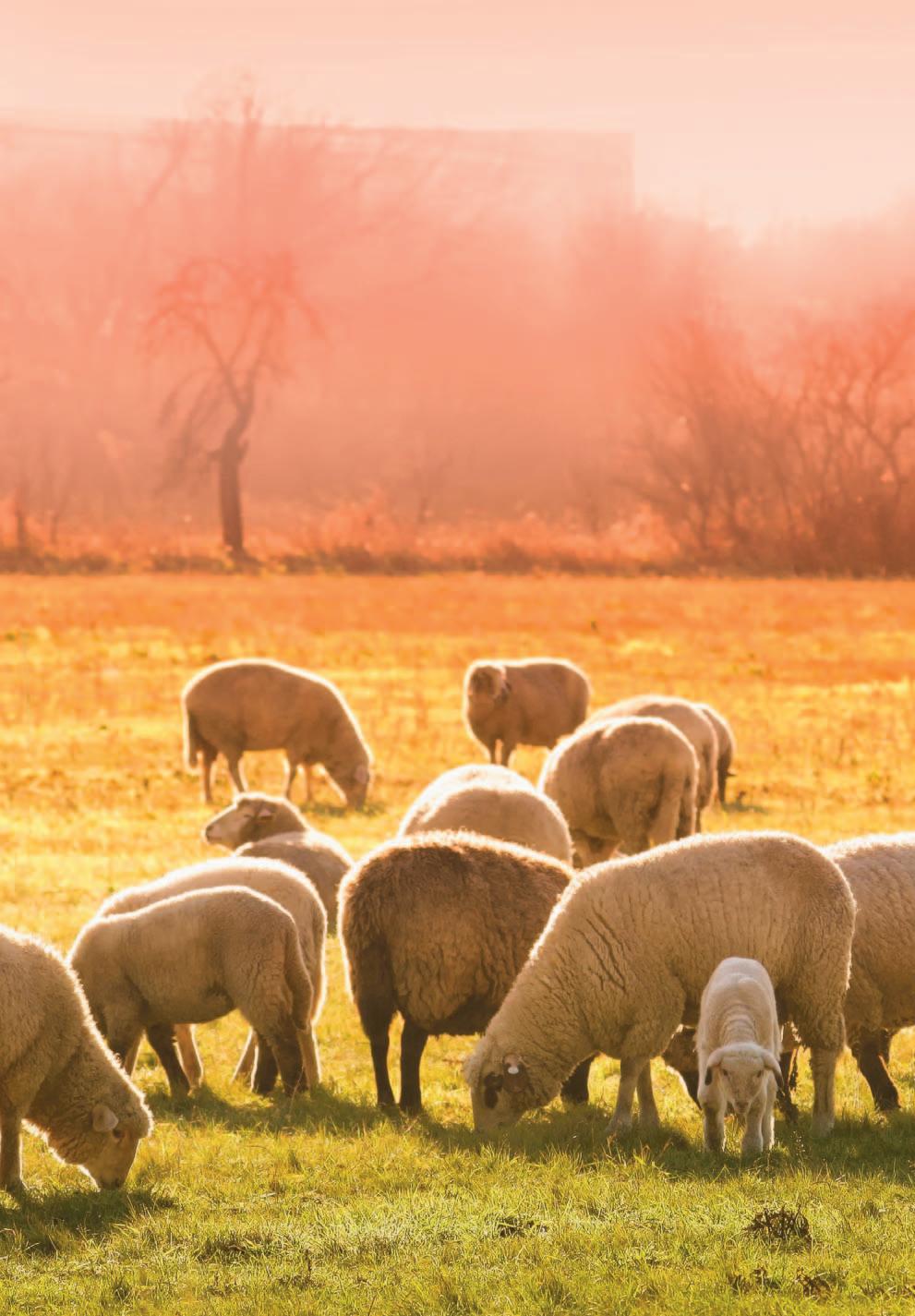
















Coxiella burnetii can cause reproductive losses in animals and disease in humans.
The disease caused by C. burnetii is referred to as ‘Q fever’ in humans, and ‘coxiellosis’ in animals.
The organism can be present in a herd or flock without causing any noticeable animal disease. However, in these herds/flocks there is still a risk of human infection. This may be the main reason for testing for C. burnetii on some farms, for example, open farms that are visited by members of the public.
Coxiella burnetii can survive many months in the environment as an infectious spore-like small cell variant (SCV).
SCV’s are resistant to heat, drying and disinfection. They can be carried several miles by the wind potentially spreading the disease over large distances.
Coxiella burnetii has been associated with abortions and stillbirths in livestock (goats, sheep and cattle) but further work is required to investigate any potential links with metritis/endometritis or mastitis.
Humans can become infected with C. burnetii if they inhale the bacteria. This could be through inhaling contaminated dust from bedding, animal hides, wool or furs, or bacteria which are aerosolised during birthing.
The role of ticks in the transmission of C. burnetii is debatable and more work is required to confirm or deny any links.
The infectious dose is very low, as few as one to ten organisms can cause infection.
Most human infections are asymptomatic with others experiencing flu-like symptoms. In rare cases the disease can be much more serious, even fatal.
Q fever/Coxiellosis is likely to be underdiagnosed due to the lack of clinical signs/symptoms in most animal and human infections.
Vaccines are available for livestock in some countries including the UK. Vaccination can protect animals against reproductive losses, and reduces shedding of the bacteria from infected animals, thereby reducing transmission between animals and from animals to humans.







Q fever is a disease caused by the bacterium Coxiella burnetii, which can spread from animals to humans. It is typically found in livestock such as cattle, sheep, and goats but has also been found in various domestic and wild animals. Coxiella burnetii infection in animals is often without clinical signs, however, the bacteria can cause abortions (sometimes abortion storms on a single farm), stillbirths, or the birth of weak offspring in livestock. In humans, infection occurs through inhalation of contaminated aerosols and dusts; and those likely to be in direct contact with birthing products such as vets and farm workers are at the greatest risk. Other transmission routes, including foodborne, are possible. Human-to-human transmission, although rare, can occur under certain circumstances. Coxiella burnetii is highly resilient, surviving for months in harsh conditions, making prevention in animals challenging.
In the UK, there is no formal control program, but a vaccine is available for livestock. Most human infections are asymptomatic or mild, but some can develop into serious illness with symptoms including high fever, eye and respiratory infections, and severe headaches. In rare cases, the infection may become chronic, affecting organs such as the heart and liver. These symptoms can be very serious, requiring prolonged treatment and may be fatal if not treated. Infection during pregnancy can result in premature birth, low birth weight, or miscarriage.




Q (Query) fever (known as coxiellosis in animals) is a bacterial infection caused by the bacterium C. burnetii. Q fever was first described in the early 1930’s as a febrile disease affecting abattoir workers in Brisbane, Australia. At the time the cause of the disease was unknown hence the “Q” for “query”.
The causative agent C. burnetii was first isolated in 1937 from human cases by Burnet in Australia, and from guineapigs by Cox in the USA.
Despite the long history of this disease, there are still knowledge gaps about the properties of this bacterium, its prevalence, and the impacts of infection.
Figure 1:
Picture of C. burnetii bacteria within an infected cell.
Arrows indicate bacteria in a Coxiella-containing vacuole (CCV) within the cell

Q2
What are the clinical signs of coxiellosis?
Coxiellosis in livestock, such as cattle, sheep, and goats, is a significant concern in veterinary and agricultural sectors due to its impact on animal health and its zoonotic (ability to infect humans) potential. Cattle, sheep, and goats are the primary reservoirs for the bacterium, and they play a crucial role in the transmission of Q fever to humans.




Signs of disease are rare, but abortions (including abortion storms) may occur in cattle, sheep and goats. Coxiella burnetii is unusual because it survives in the environment for many months as an infectious spore-like small cell variant (SCV) form that is resistant to heat, drying and disinfection.
In addition to direct aerosol transmission from infected animals, this SCV can also be carried by wind, allowing infection to be spread over wide areas. It is difficult to prevent animals becoming infected and there are no formal control programmes in the UK. However, there is a vaccine for use in livestock in the UK (see Q7).
In cattle, C. burnetii infection is often subclinical, meaning infected animals do not show clinical signs of illness. When clinical signs do occur, they mainly involve the reproductive system and can include:
• Abortion, stillbirth or perinatal mortality: foetuses or calves die before, during or shortly after calving
• Weak offspring: calves may be born alive but lack vigour and have no suck reflex. Such calves may die within hours of birth
• Retained Foetal Membranes (RFM): occurs when the foetal membranes are not expelled beyond 24 hours post-calving and remain attached to the uterus
• Infertility/Subfertility: the significance of C. burnetii infection as a contributory factor to bovine infertility is still unclear and further investigations would be needed to clarify this
It is currently unclear whether C. burnetii can cause inflammation of the uterus (metritis/endometritis) or mastitis.
Coxiella burnetii is shed mainly in birth products (birth fluids, placenta), but may also be shed in vaginal mucus, milk, and faeces. Urine and semen are other potential routes of shedding.

Like cattle, sheep and goats are often subclinical carriers. However, when clinically affected, signs may include:
• Abortions: sudden abortion storms can occur, particularly in late pregnancy. This is one of the most notable clinical signs in sheep and goats
• Stillbirths and weak lambs/kids: offspring may be born weak or die shortly after birth
• Infertility: this is less commonly noted as a clinical sign compared to abortion in sheep and goats
Goats are more likely than sheep to show clear signs of coxiellosis, such as abortion. Both species can shed the bacteria through birth fluids (in high levels), milk, urine, and faeces, particularly around the time of parturition.



In flocks or herds known to be infected with C. burnetii, the period around parturition represents the most significant risk period for transmission due to the large amount of environmental contamination associated with both abortions and normal births.
• Aerosol Transmission: this is thought to be the major route of transmission. Contaminated dust or aerosols from the environment, such as soiled bedding from sheds or pastures where abortions have occurred, can be inhaled by other animals (or humans), leading to infection. Aerosols containing infectious C. burnetii can also be transmitted several miles by wind, but this depends on wind speeds and other meteorological conditions
• Direct Contact: the bacterium is spread through direct contact with infected animals or their birthing products. This is especially true during parturition, as high concentrations of C. burnetii can be present in birthing fluids and placenta
• Ticks: rarely, ticks that feed on infected animals can become vectors, transmitting the bacterium to other animals. However, there is some controversy over the importance of this route of infection

Figure 2:
Coxiella burnetii is usually transmitted from host to host by the inhalation of particles in the air such as dust from bedding contaminated with birthing products from an infected animal. The bacteria can be shed in milk, urine, faeces as well as birthing products. Cattle, sheep and goats are the main reservoirs of C. burnetii, but domestic and wild animals can also be infected. Other routes of transmission such as via contaminated milk which is considered low risk compared to aerosol transmission; or involving a vector - (ticks) have been suggested but evidence is lacking.




Infection usually results from inhaling the bacterium on contaminated dust particles (from infected materials such as bedding contaminated with birthing products from infected livestock) and aerosol dissemination of the spore-like SCVs. The infectious dose is very low (1-10 bacteria) so brief inhalation of infected aerosol can cause infection.
Contaminated animal hides, wool or fur are other potential sources of infection, and abattoir workers are at particular risk. Very occasionally, outbreaks occur in urban areas, usually caused by windborne spread from nearby livestock premises. The EFSA (European Food Standards Agency) stated in 2010 that there was no conclusive evidence that consumption of milk and milk products (both raw and pasteurised) containing C. burnetii can cause clinical Q fever in humans. Compared to aerosol transmission originating from contaminated birth products, the consumption of unpasteurised milk containing viable C. burnetii is considered to be of low risk, but not negligible. Transmission from animal reservoirs to people via infected ticks is a theoretical possibility but the evidence for this is lacking.
Coxiella burnetii is considered to be endemic in ruminant livestock in Great Britain, especially in dairy cattle, meaning infection is widespread. However, herds and flocks where C. burnetii has been detected may not show any apparent clinical disease signs or reproductive losses. To determine if C. burnetii is the cause of abortion it is important that foetus(es) and placenta(e), or foetal and placental samples are submitted to a Veterinary Investigation Centre (VIC) for investigation. All ruminant abortion samples submitted to APHA (Animal and Plant Health Agency), APHA partner postmortem providers, or SRUC (Scotland’s Rural College) are screened for C. burnetii. The detection of C. burnetii was made reportable through amendments to the Zoonoses Order in 2021 and is statutorily reportable to APHA. This applies to farms in England, Scotland and Wales.
In the 20 years from 2003 – 2023 approximately 100 confirmed Q fever abortions were reported in cattle (~50%), sheep (~20%) and goats (~30%). The 2023 Veterinary Investigation Diagnosis Analysis (VIDA) Report shows that there were seven confirmed diagnoses of C. burnetii related abortion in cattle and one in goats. While these numbers may seem low, the criteria for confirming a diagnosis of Coxiellosis is strict. For C. burnetii to be considered the main cause of abortion there needs to be a positive modified Ziehl Nielsen stain, validated by positive C. burnetii PCR on placental tissues, and accompanying histopathological changes within the placenta (placentitis) that is consistent with C. burnetii infection.



These confirmed diagnoses are likely to represent “the tip of the iceberg” in terms of the numbers of flocks and herds where C. burnetii infection is present. Confirmed diagnoses of abortions/stillbirths due to C. burnetii are much lower than the total number of cases that are positive by C. burnetii PCR. This may be due to the type and quality of the samples submitted to the diagnostic laboratory, including whether a placenta is submitted or not, and if the sample has degraded. Thus, there are many C. burnetii PCR positive placental and foetal fluid samples where a diagnosis of Coxiellosis is unable to be confirmed.
Figure 3:
Modified Ziehl Nielsen-stained impression smear of a placenta from a case of coxiellosis abortion in a goat. Coxiella burnetii organisms (red) are found in clusters or as individual organisms throughout the smear.

How is coxiellosis diagnosed?
Diagnosing coxiellosis in livestock involves several methods:
• Serology: blood tests to detect antibodies against C. burnetii, indicating exposure to the bacteria.
Serology is not always a useful tool for immediate diagnosis as animals may remain seronegative for several weeks post-abortion. Also, a seropositive result may not be reflective of recent infection, nor can it confirm C. burnetii as the cause of abortion. Vaccinated animals will also be positive by serology.



• PCR (Polymerase Chain Reaction): detects the DNA of C. burnetii in samples like milk, vaginal swabs, or placental tissues, and foetal fluid. Fresh placenta (including cotyledons and intercotyledonary membrane) is a very important sample for PCR and further diagnostic investigation. Foetal fluid includes thoracic fluid or peritoneal fluid. Usually, a smear of placenta (preferable sample) or foetal stomach contents is tested by Modified Ziehl Nielsen stain first, and if positive (e.g., Figure 3), the sample will be tested by PCR.
Bulk tank milk (BTM) sampling has been used to gather information on dairy cattle, goat and sheep herd/flock exposure, through detecting anti-C. burnetii antibodies and the presence of bacterial DNA by PCR. One way that this test can be done is by using Q Test, (which uses PCR) and is validated for cattle and goats only. Detection of antibody or fragments of bacterial DNA in BTM does not necessarily indicate that infection is currently causing disease issues in the herd. Previous work conducted in 2014-2015 has shown that the apparent prevalence of BTM antibodies against C. burnetii in dairy cattle in GB was around 80%. The high prevalence and wide geographic distribution confirmed that C. burnetii is spread widely across GB and that, at the time of the study, a large proportion of the dairy herds sampled had been previously exposed to the bacteria.
If abortions/stillbirths occur on farms where positive BTM PCR results have been reported, then it is important that foetus(es)/stillborn neonates, placenta(e) or samples from affected animals are submitted for veterinary and laboratory investigation. Other causes of abortio/stillbirth may also be found.
PCR positive vaginal swabs have been taken from seronegative animals showing the importance of PCR analysis over serology. Post abortion, bacteria are shed in vaginal mucus (goats 2-3 weeks, cattle < 2 weeks, sheep ~ 2 weeks, but can be longer), milk and faeces. Sampling the vaginal mucus of an aborting animal for PCR testing very close to the time of abortion (ideally on the day of abortion), rather than weeks later, is most likely to achieve a positive result if the causative agent is C. burnetii. However, without a full investigation of the foetus and placenta then it is not possible to confirm that the abortion was caused by C. burnetii. Shedding of bacteria in milk can occur for longer but may also occur after normal pregnancies.
• Histopathology: Ideally a fresh placental sample (including cotyledons and intercotyledonary membrane) should be fixed in formalin. Sometimes the placenta is degraded (autolysed). These samples may still be useful for reaching a diagnosis, but histopathological examination may be compromised. Severely autolysed and mummified placentae are unsuitable for histopathological examination. The histopathologist will confirm if there are compatible placentitis lesions; and they will also advise on other findings, including observation of other abortion pathogens. Histopathology is most useful if accompanied with other tests, e.g., PCR and IHC (Immunohistochemistry). Some international laboratories detect the bacteria within tissues by IHC, but this is not routine in the UK.
• Culture: Coxiella burnetii is an Advisory Committee on Dangerous Pathogens category-3 pathogen.
Culturing of C. burnetii is not performed in routine veterinary diagnostic laboratories due to the highly infectious nature of the bacterium and safety concerns. Coxiella burnetii is an obligate intracellular bacterium and growth of the organism requires specialist techniques performed under Biosafety Level 3 (BSL3) laboratory conditions.



Coxiellosis in livestock poses a significant risk to human health, particularly for those who work closely with animals, such as farmers, veterinarians, and abattoir workers. Studies have shown that the prevalence of C. burnetii antibodies in livestock farmers is higher than in the general population. As livestock are often subclinically infected, human infections can occur without obvious signs of a problem in the herd/flock. Therefore, public health strategies also include raising awareness about the disease among those at risk, promoting personal protective equipment (PPE) use, and ensuring proper hygiene and handling practices.
Roughly 50-100 human cases of Q fever are reported each year in Great Britian; these are generally sporadic and not linked but there have been some outbreaks where epidemiological investigation has linked case clusters to specific sources.
2002- Cardboard manufacturing plant South Wales; outbreak amongst workers (37% infected) suggested to be associated with renovation of an office block and disturbance of straw board which may have contained a concentrated source of SCV form C. burnetii.
2006- Abattoir workers in Stirling, Scotland. One hundred and ten workers seroconverted; of these 56% had symptomatic illness. The sheep lairage was thought to be the potential source of exposure.
2007- Gloucestershire, England. Thirty confirmed human cases between May and July, of which 24 were hospitalised suggesting a potentially larger outbreak. Windborne spread of C. burnetii from nearby farms was thought to be the probable source of infection.
In 2007 Q fever emerged in the human population in the Netherlands; between 2007 and 2010 more than 4000 human cases were reported, mostly in the south in areas with intensive dairy goat farming. The most important risk factor identified was living within 5 km of an infected dairy goat farm, with occupational exposure playing a smaller role.





Most people who get Q fever will have no symptoms. Others (around 40%) will experience acute self-limiting flu-like symptoms such as headaches, fever, chills, muscle soreness and, in some cases, may develop pneumonia. A small number of cases may progress to chronic disease lasting more than six months and can occur months to years after acute illness, although chronic Q fever can sometimes occur without a history of acute illness. Chronic Q fever is associated with endocarditis (inflammation of the inner lining of the heart), hepatitis (inflammation of the liver), and inflammation of the bone or bone marrow (osteomyelitis). These symptoms can be very serious and may be fatal if not treated.
Infection during pregnancy can result in premature birth, low birth weight, or miscarriage.
It is likely that the occurrence of Q fever in humans is under-reported as most people suffering a mild flu-like illness are unlikely to be aware that it could be Q fever. It is important that if seeking medical attention for flu-like illness, farmers, vets, and others working with livestock inform their doctor if C. burnetii has been detected in the livestock they have been working with.
Laboratory diagnosis of C. burnetii as a causative agent in humans is notifiable to the UK Health Security Agency.
Current evidence indicates that C. burnetii strains originating from goats are the most likely to cause infections in humans, followed by strains from sheep. Strains from cattle are considered the least likely to infect humans, although there is a higher risk of infection from contact with aborted or aborting material from infected cows compared to subclinically infected cows. From 1987 to 2014, 90% of Q fever cases reported in humans in Europe were linked to contamination from sheep and goat products. Ongoing research on C. burnetii strains may lead to changes in our current understanding of the risk of Q fever from different livestock species.
Human vaccination against Q fever with an inactivated whole bacterial vaccine (Q-VAX®) is performed for high-risk occupational groups in Australia only. However, the vaccine carries some risks; administering it to individuals previously exposed to C. burnetii can lead to abscesses or widespread inflammatory reactions. To identify prior exposureto C. burnetii, skin tests and blood tests are conducted to evaluate cellular and antibody responses to the bacterium, respectively. Only people that have not been previously exposed to C. burnetii can be vaccinated. There are no human vaccines available in any other country.





Preventing and controlling coxiellosis in livestock involves several strategies:
Vaccination: Vaccines for coxiellosis are available for livestock in UK and Europe, although no livestock vaccines are available in Australia. Vaccination can reduce the shedding of the bacteria and protect animals from reproductive losses.
Coxevac®, also based on inactivated C. burnetii, is licensed in the UK and Europe for cattle, goats and following recent studies at the Moredun Research Institute is now licensed for use in sheep. Vaccination of goats reduces abortion caused by C. burnetii and shedding of bacteria in vaginal mucus, faeces and milk.
Vaccination of cattle reduces the risk of animals shedding the bacteria should they become infected. In sheep, vaccination can reduce shedding of the bacteria in vaginal mucus, faeces and milk.
Injection site reactions are not uncommon particularly in goats receiving their annual boosters after their two-injection primary course. It is also not uncommon for goats to experience a reduction in milk yield following vaccination.
Biosecurity Measures: Implementing strict biosecurity practices, such as:
• Proper disposal of birth materials (placenta, aborted foetuses) to reduce environmental contamination
• Isolation of animals that have recently given birth or aborted
• Regular cleaning and disinfection of animal housing and equipment
Tick Control: Controlling tick populations may be an effective preventive measure (see Moredun Factsheet Vol 9 No. 1) although the importance of this route of transmission is unclear.
Monitoring and Surveillance: Regular monitoring of livestock for signs of coxiellosis and maintaining surveillance programs to detect and manage outbreaks.




To reduce the risk of Q fever transmission on farms, both human and animal health risks must be managed through good hygiene and farm practices. The main route of transmission is via inhalation of aerosols; however, it is also important to avoid ingestion of the bacteria:
1. Hand Hygiene: Wash hands thoroughly several times a day, especially if visibly dirty, and always before eating, smoking, or after finishing work.
2. Wound Care: Wash skin wounds immediately with soap and water; cover with a waterproof dressing.
3. Handling of Contaminated Materials: Use waterproof gloves and extra personal protective equipment (PPE) like facemasks (EN149-FFP2 standards) and goggles when handling potentially infected materials (e.g., placentas, aborted foetuses) and dusty materials contaminated by animal excretions such as bedding.
4. Protective Clothing: Store protective clothing separately from regular clothing, and do not wear contaminated clothing at home.
5. Avoid Ingestion: Avoid eating or smoking in animal areas and use disposable facemasks (EN149-FFP2 standards) in high-risk areas.
6. Tick Prevention: Use tick repellents, check the body for ticks daily, and remove any promptly (although the importance of this route of transmission is unclear).
7. Pregnant Women: Avoid close contact with livestock, particularly placenta and amniotic fluids during calving, lambing or kidding.





1. Animal Quarantine and Observation: Maintain a closed flock/herd or quarantine new animals for 3-4 weeks.
2. Control Outbreaks: Investigate abortion and stillbirth outbreaks promptly and isolate affected animals restricting access by other animals and people. Use separate clothing for affected animals.
3. Dust and Aerosol Control: Minimise dust and aerosol production to prevent airborne spread, particularly in livestock buildings.
4. Proper Waste Disposal: Treat bedding, and birth products (such as placentas) as high-risk waste and dispose of them appropriately. Foetuses, stillborn animals and placentas should be disposed of in accordance with Animal By-Products Regulations, preferably by incineration.
5. Environmental Management: Avoid handling contaminated bedding on windy days, dampen surfaces before using high-pressure hoses, and disinfect surfaces regularly. Coxiella burnetii is resistant to many commonly used farm disinfectants however, Virkon® S can be used.
6. Manure and Bedding Management: Compost bedding and stack manure away from livestock, allowing it to heat and decompose properly for at least 3 months before spreading it away from human and animal areas.
7. Vermin and Parasite Control: Implement strict vermin control measures and keep pets away from contaminated materials – it is known that other species such as rats, mice, cats and wildlife can be infected with C. burnetii.
8. Visitor Restrictions: Limit access to farms to reduce the risk of disease transmission.
By following these guidelines, the risk of Q fever and other zoonoses can be significantly reduced.
Moredun Research Institute continues to be involved in work to develop innovative vaccines and diagnostics for livestock reproductive diseases. Currently available vaccines are based on inactivated C. burnetii bacteria which have to be cultured at Biological Safety Level 3 and cause significant postvaccination reactions. A recent EU-funded project (REPRODIVAC: https://www.reprodivac.eu/) builds on previous work led by MRI on coxiellosis and aims to develop subunit vaccines (i.e. vaccines consisting of components of the bacteria rather than the whole bacteria) for coxiellosis which will be safer to use and easier to manufacture. In addition, complementary diagnostic tests will be developed with the ability to discriminate between vaccinated and infected animals which will help with identifying infected animals in a population of vaccinated animals.
MRI is also working with APHA and several European partners to standardise Q fever surveillance across Europe, including routine typing of C. burnetii strains using whole genome sequencing (Q-Net-Assess: https://q-net-assess.com/).
https://www.gov.uk/government/publications/q-fever-good-practice-forfarmers/q-fever-information-for-farmers
www.nhs.uk/conditions/q-fever/ www.gov.uk/guidance/q-fever

Produced by The Moredun Foundation Pentlands Science Park, Bush Loan, Penicuik, EH26 0PZ, Scotland
Phone: +44 (0)131 445 5111
E-mail: info@moredun.org.uk Website: www.moredun.org.uk




